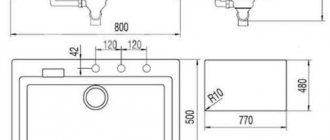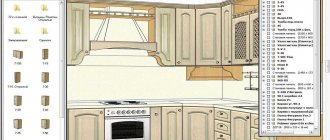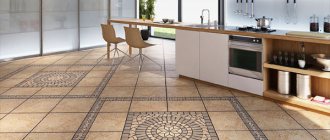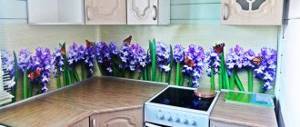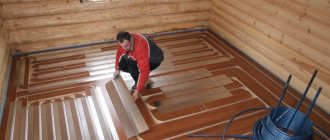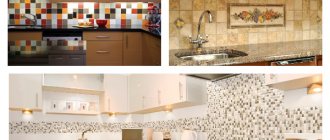The issue of creating coziness in the kitchen and providing convenience there can be solved in different ways. For example, by placing a variety of trinkets, napkins, bouquets, or vice versa - by excluding all unnecessary items from sight. But there is one thing that will no doubt appeal to proponents of either approach. This is a railing system.
Installing roof rails in the kitchen will allow you to get rid of unnecessary running around in search of the kitchen utensils you need at the moment.
Railing in the kitchen
How to secure a roof rail in the kitchen - general recommendations
Regardless of the structure you are attaching, you must follow the following recommendations for attaching roof rails in the kitchen:
1. Place roof rails in the kitchen in the area where you most often prepare food.
Rails next to the sink and stove
Railings for the kitchen: how to arrange them better? Here's our advice.
2. Hang one large and long (about 1-2 m) railing or several small ones, the length of which is approximately 20-50 cm. For example, one railing next to the stove and sink, and the other in the place where the desktop and cabinets are located .
The recommended height of the railing in the kitchen above the countertop is from 40 to 50 cm. And the distance from the top cabinet and its bottom shelf should be at least 5-7 cm.
Rails over the kitchen table
3. The design of the kitchen rail (crossbar) consists of a tube, two brackets with which it is secured, and 2 plugs on the sides for aesthetics.
4. Accessories and hooks, which are specially produced for railing systems, are placed on the crossbar. The main hooks for the kitchen railing are put on before securing it, which can be moved but not removed.
5. When using hanging type roof rails, it is necessary to pay special attention to the fastening, which should be as reliable as possible, i.e. so that nothing falls from it on your head.
6. Horizontal or inclined shelves for railing in the kitchen can be used to store cookbooks with your favorite recipes so that they are always at hand.
Shelves for kitchen railing
You may also be interested in an article about the types of kitchen stoves - see the link: https://remontspravka.com/kitchen-stove/
Kitchen stoves: which ones are better - you will also find on our website.
You can learn about electric kitchen stoves from the following article on our website.
How to install roof rails in the kitchen - step-by-step instructions
If you decide to install roof rails in the kitchen yourself, you should follow certain instructions. And if you do everything consistently, step by step, then how to hang roof rails in the kitchen is not a problem.
1. Prepare the necessary tools:
Railing installation kit
- Glass drill
- Drill or hammer drill
- Self-tapping screws
- Fasteners
2. Assemble the railing structure.
3. Mark the locations using a level on the surface of the wall for drilling. Important! Many people wonder how to hang a roof rail in the kitchen if the wall is covered with tiles? There is nothing complicated here:
Different drill bits for tiles
1) First make a hole in the tile using a special drill.
2) Using another drill, make holes in the wall.
4. If the length of the railing is more than 3 m, then provide several support points (at least 3).
Railing fixation scheme
5. Insert dowels into the holes and attach special pins using self-tapping screws. The support of the entire structure will rest on these pins.
6. All supports are installed. Insert the tube (rail) through the hole and secure it in the desired position.
7. If the railing is of a vertical type, then before final fixation hang all the components in the form of dryers, baskets, etc.
8. Install the plugs.
Plug “Retro” for railing
9. The installation of the roof rails in the kitchen is complete. Hang hooks and arrange your kitchen utensils.
Railing installation was successful
What types of filters are there for kitchen hoods: see their review here.
Installation
Contents
Before installation, you need to determine how to fix the crossbar on the wall. It will depend on the wall material. The main thing is not to fasten the crossbar “tightly”, that is, take into account that the railing can be dismantled and reinstalled elsewhere on the wall.
It is also impossible to fix the crossbar too loosely, since it must withstand the weight of objects that will be on hooks or shelves.
After marking the walls, installation begins. The holders are placed on a metal base and lightly secured with screws. The holders should be positioned so that the screws are at the bottom and are not visible. Then you need to attach the entire structure to the wall in order to mark points for drilling for fasteners, drill holes, put plugs on both sides on the base of the railing and secure it to the wall with screws or self-tapping screws. At the end, put on hooks or install shelves.
Bracket Attachment
That's all, you can use it. By the way, the roof rails do not require special care; it is enough to wipe them from dust from time to time.
It is advisable to install the roof rails not too high, optimally at the eye level of an adult. To work, you will need a pencil and a building level to mark the wall. It is important to maintain symmetry, especially in the case of simultaneous installation of several roof rails.
Accessories and hooks for kitchen railings: tips for their placement
Here are our tips that should help you in this matter. So:
1) No skimmers or ladles should be placed above the tiles; steam and grease will cause them to lose their original shine.
2) It is better to hang a shelf next to the tiles for railing in the kitchen. On this shelf there will be various spices and salt, which are always necessary on hand.
Railing with a shelf for spices above the stove
3) You should install a paper towel holder not far from the sink.
4) Plates and cutting boards should be stored separately, for example on hanging shelves.
5) Near the stove, it’s a good idea to install hot pots on hooks for the kitchen railing.
Hooks on the railing with potholders for hot dishes
When choosing hooks and other accessories for roof rails, consider the interior of the kitchen. For modern styles, roof rails made of chrome materials are perfect. And for a kitchen in a classic style - roof rails coated in bronze or gold. You can read more about this in the article on our website “What types of roof rails are there - description and review.”
Installation height
In order to decide at what height to hang the railing in the kitchen, you need to know two things:
- what items will be on the railing;
- in which area of the kitchen is the suspended structure installed?
It is also worth taking into account the location of sockets and other communication nodes. It is best not to place a suspended structure over gas pipes or electrical power sources for the stove.
There is no general rule for installing roof rails. The main thing is convenient access to things suspended on the mounting structure. To do this, you should choose the largest item that will be located on the railing and measure its height when suspended. Add another 2 - 3 cm to this indicator. The resulting parameter will be the required height that must be measured when installing the suspended structure from the tabletop surface.
In cases where the railing is used only for small and oversized items, its design is placed at chest level. This rule is suitable for any type of railing. An exception may be the case when the structure passes over the hob or stove. In this case, it is appropriate to place the railing at a higher distance, since grease and drops from cooking can fall on things located on the railing.
Multi-tiered roof rails are installed one above the other. An open wall without wall cabinets is best suited for this. For an aesthetic appearance, each tier is fixed at the same distance from each other. In this case, the first tier is placed at the minimum height, for the most oversized items. The remaining rails are mounted at such a distance that things on them can be easily reached.
- Save space, making the interior more free;
- Allows compact storage of kitchen utensils;
- Easy to attach and reinstall.
Used for hanging:
- Kryuchkov;
- Shelves;
- Holders;
- Knives and scoops;
- Detergents and towels;
- Cutting boards;
- Potholders;
- Pan.
Storage and organization of the workplace
The kitchen workplace is designed with the selection of optimal equipment. All equipment and equipment must be of high quality, durable, so that the usual design and comfort predispose to preparing delicious food. The main rule for properly organizing a kitchen workplace is to arrange the elements so that they do not interfere. For example, hanging pipes, or rails, above the tabletops for storing ladle, ladles, knives.
First, the main appliances are placed: the stove, sink and refrigerator for the home. Next to them are various kitchen cabinets, which simultaneously serve as a stand for household appliances and a place to store dishes and other appliances. It is important to immediately determine the height of the outlet.
If there is not enough space in the kitchen or the cabinets are not spacious enough, the use of rails is recommended. They make it easier to put small and necessary things in their places, free up space in the room, and make it look tidy and cozy. At what height to hang kitchen cabinets to make it convenient, find out at this link.
Hanging railing
The crossbars that are attached directly to the bottom of the upper modules of the kitchen unit are classified as hanging. Structurally, they do not differ from the previous one in the method of attaching the crossbar. In this case, holes are drilled not in the wall, but in the lower part of the upper drawers. It is recommended to maintain a distance from the wall to the mounting points within 5 centimeters.
An original solution for storing pots, ladles, frying pans and other utensils is to place them on a hanger above the island table in a large kitchen. In this case, the question arises at what height should the roof rails be hung in the kitchen? It must be said that there are no clear standards or recommendations for installation. It all depends on the height of the owner of the kitchen and the size of the dishes that will be hung. Of course, it should be comfortable and allow you to easily remove the dishes from the hanger and hang them back. The best option for placing such a pendant is in kitchens with high ceilings. The system is mounted using chains and anchor bolts that resemble hooks. However, it is better to entrust the installation of this structure to professionals.
Hanging rails are made from stainless steel, antique tin or copper. The main thing is to match the style and decor of the kitchen. Storing kitchen utensils under the ceiling gives you access to everything. There is no need to look for the necessary thing in the closets.
Rails: fastenings, at what height to hang them
Railings are horizontal parts, the base of which is presented in the form of a plank:
- usually they are located in a horizontal position;
- it is preferable to use them in the apron area or along the side walls;
- if the design allows, the rails are placed on the decorative front parts of the hood, that is, they are located almost under the ceiling;
- Shelves or hooks are installed on the roof rails. They are very convenient for this purpose, since the number of elements can be constantly changed, adapting the installation to your own needs.
Sometimes railing systems are installed in a vertical position. This is only necessary to create an unusual design, sometimes to save space. In this case, a long strip is needed, which is attached by joining to the ceiling above and to the floor below. Such interior parts are most often sold in metal, but it is possible to purchase options made of glass, plastic or wood.
Modern roof rails often have additional fastening elements, thanks to which you can hold glasses, baskets with food or small items. Comfortable, often voluminous stands can be attached to them.
Railings in a vertical position sometimes provide for mounting a small stand on them in the form of a table. They can be used to organize a breakfast area or as an element of a home bar counter.
Long
Apply to the entire wall along or across. Designed for kitchens with a large area. They add comfort to cooking and serve as a multifunctional design element. Suitable if wall cabinets do not fit into the interior design of the room. They perfectly replace their functions, without cluttering up the space with a series of objects in the same color.
In addition to roof rails, it is advisable to use hanging shelves to place heavier or bulkier items on them.
Multi-tiered
Designed to significantly save space in kitchens with a small area. They are usually arranged in a long vertical row and take up as much space as a kitchen cabinet would. Sometimes they are mounted in a place where there are no hanging shelves and cabinets or in an interior without top drawers, that is, they are located between volumetric elements.
Circular
Useful for placing towels, as well as small parts of kitchen equipment, such as knives. Suitable for placing spices on them or neatly placing plates of fruit. They can also serve as a mount for a stand on which you can place any elements while cooking. These are stylish, modern options, while the design is suitable for both classic kitchens and modern design. How to arrange a kitchen counter, you will also need rails here, read here.
Circular rails are often used to attach a variety of drawers. To do this, a plug is mounted on them, on which the panel is in turn placed. These parts snap into place during installation.
Location options
Most often, roof rails are placed in the area of a ceramic apron in a horizontal version. If they are installed vertically, they are usually complemented by furniture, that is, they serve to hold fairly large objects. When choosing a height, you should be guided by your own taste and preferences; strict instructions are not given.
If you plan to attach hooks to the rails and hang any tools on them, then it is advisable to place them in the upper part of the wall. If you install shelves or various cleaning products on them, you can place the rails in the middle or in the lower compartment of the room. Read how to equip a small kitchen in a Khrushchev building here.
Recommendations for optimal placement of roof rails:
- If the kitchen is completely made in a minimalist style or is equipped with elements of Japanese culture, you will have to abandon the roof rails, since it is almost impossible to fit them in harmoniously. The only exception will be glass rails, on which only aesthetic elements are placed.
- Italian interior and Provence require the presence of rails on which any elements can be installed. You need to care not about the beauty of the device, but about its practicality, so these elements can be placed anywhere. When using them, it is advisable to protect the interior from the use of various wall cabinets, since a single-color shade is not suitable for the given design, but to replace them with bright furnishings.
Railings for the kitchen
Shiny elements of the kitchen interior are increasingly becoming fashionable. Rails are no exception. Installing roof rails in the kitchen fills the kitchen space with modern fashion trends and also makes the kitchen more functional.
Railings for the kitchen: purpose
In English, the word railing means “pipe” or “crossbar”. The essence of this invention is quite simple. Thanks to various configurations, the rails can accommodate plates, cutlery, glasses, household appliances, kitchen towels, spices, cookbooks, and detergents. This invention allows housewives to save space on work surfaces.
Mounting rails in the kitchen can be either horizontal or vertical.
Properties of roof rails
Initially, this design was put into operation in restaurants. This saved space on the surface, although all the necessary kitchen utensils were at hand. Nowadays, modern housewives prefer to install this accessory in their kitchens.
Pros of railing
- the design is cheap and easy to install;
- You can install the railing on any vertical surface in the kitchen;
- The railing material (steel) is resistant to moisture, temperature and can withstand any load;
- The variety of colors and configurations of roof rails allows you to choose them for any interior.
Before purchasing a roof rail, you need to decide on the style of the product. Manufacturers offer a wide range of caps and roof rail pipe textures.
Type of roof rails
Standard roof rails are round, with a diameter of 16 millimeters. But there are models that have a rectangular cross-section. There are corner rails, the bend angle can be 90 or 135 degrees. They are suitable for equipping the corner apron (the space between the wall cabinets and the work surface) of the kitchen.
The color range of roof rails is varied. You can order roof rails not only in chrome and nickel (suitable for classic style), but also in copper, brass, and gold. There is also the option of painting the railing with a special paint in the color you need to implement your design idea. Basically, painting is used for high-tech style.
When choosing a roof rail for a kitchen, matte chrome is only suitable for modern styles, for example, modern or new wave.
To create a light, airy interior, glass rails (colored or frosted) are used.
Accessories for kitchen railings
Manufacturers equip roof rails with various accessories.
Any railing can be supplemented with additional accessories.
The most common type of railing accessories are “S”-shaped hooks. Kitchen utensils are hung on them.
In roof rails with hanging baskets (mesh), you can store jars of spices, detergents and, for example, rolls of foil.
Railing location
Traditionally, roof rails are located horizontally on the kitchen apron. But there is also an option for a vertical arrangement, when the railing is combined with the furniture. For example, the railing is combined with a bar counter or table top (in this case, the railing is attached to the ceiling). You can install shelves (made of wood, glass or metal) on such a railing.
At what height should you hang kitchen rails?
There is no standard height for placing rails. It all depends on what you need the railing for and what kind of shelves or hooks you are going to hang on it. If there will be hooks for kitchen utensils on it, it is recommended to place the rail at the top of the kitchen apron; if the rail will have shelves for detergent, bowls, rags, etc., install it in the middle or in several rows on the apron.
A kitchen rail is a convenient and functional design that adds flair to the design and makes it easier for the housewife to work in the kitchen.
Mounted systems
Hanging systems for railings are functional elements that housewives very often use in the kitchen. The main list of such accessories includes:
- Hooks with or without the possibility of removal, rearrangement.
- Baskets or other containers for storing surface cleaning products or products, such as vegetables.
- Containers for storing baked goods, such as baked goods. They are often produced closed, so you can also install items there that should not be exposed to weather.
- Special holders for glasses, bottles, as well as regular cups and glasses.
- Volumetric cups where you can put small but long objects, such as knives or forks. If you use these items for their intended purpose, then you need to pour salt, sugar, chopped pepper or other seasonings and healthy ingredients into them. Some housewives use them to store small berries, as well as bay leaves and other greens.
- Shelves. There is a wide variety of their choice: hinged, with the ability to close, multi-tiered. They are used to store any elements, sometimes even those distracted from the cooking process.
- Towel holders. If they have several tiers, you can additionally hang potholders on them.
Advantages and disadvantages
Positive sides:
- Typically, all elements for hanging systems are made of stainless steel. This completely deprives the owners of problems with them. They last for many years, and due to their functionality they are constantly needed. Their high strength and durability help reduce repair costs.
- All elements are equipped with a high-quality coating, which usually contains glitter.
- It is possible to select the texture and shade of wall hanging systems in harmony with the design of the kitchen and all kitchen appliances.
- Mobility. During the entire period of use, it is possible to rehang the elements.
- Everything is in sight, you can take in the details at a glance, so finding a lost element will not be a problem.
- To take any item, you do not need to open the drawer. It is enough to carefully remove the element from the shelf or hook.
- An excellent addition to the interior.
- Freeing up a lot of space.
- It is very easy to care for the shelves, since they are arranged in a free order, and you can wipe off dust from them in one motion.
You can equip a separate structure for placing seasonings or rare products added to dishes in small quantities. It is also possible to sort them. They will remain unchanged, since they can be taken without mixing during searches, and children will not get to them if parents place the roof rails higher than their height.
Flaws:
Install additional organizers
See all about new roof rails, hanging systems and other kitchen accessories here:
Hooks
Can be attached to any surface without grease. It is allowed to install them to any facing coating. Household goods, towels, aprons, bags or potholders are attached to them . There are hooks with Velcro. They are ideal for quick installation. No additional elements in the form of a hammer, nails or screws are required. It is enough to wash the surface, if it becomes dirty, wipe it dry and attach this element.
Special shelves
Corner and straight shelves are sold. They are made from wood, glass or metal. Depending on what will be stored on them, their thickness is selected. It is possible to purchase an option with decor. These elements can even become a work of art, but then it is also worth storing things of light weight on them. Typically, simple, level shelves are used to fill cabinets, on which all the utensils that could be stored in cabinets are installed.
Magnets holders for knives in the interior
Special devices make it easy to install knives. There is no need to place them in a closet, where they are difficult to find, or to install them in a special container. Attaching a knife to a magnet reduces the risk of injury, since it is stored separately in a designated place and cannot cause injury when searching for another item. Always nearby. If necessary, it can be quickly detached from the mount and used for its intended purpose.
Other railing options
- containers for small items;
- baskets for food or bottles, small boxes;
- hangers for dishes, cups;
- book holders;
- cups;
- soap dishes.
Proper use and care of the accessory
The rails are very durable, so if they are installed evenly, nothing threatens their integrity, unless heavy structures are installed on them. Using these elements, you can place any kitchen utensils in a convenient order.
The disadvantage is the constant openness of objects, since a large amount of dust can get on them. This problem can be solved by daily cleaning.
Railings help save space in the kitchen, improve design and make the placement of many parts comfortable. In order for them to serve for a long time, you need to choose them from materials suitable for a particular design and install them where they will be most appropriate.
The issue of creating coziness in the kitchen and providing convenience there can be solved in different ways. For example, by placing a variety of trinkets, napkins, bouquets, or vice versa - by excluding all unnecessary items from sight. But there is one thing that will no doubt appeal to proponents of either approach. This is a railing system.
Installing roof rails in the kitchen will allow you to get rid of unnecessary running around in search of the kitchen utensils you need at the moment.
Railing in the kitchen
Types of roof rails
These designs are divided into two main types:
- Multi-tiered. (Used, as a rule, in small kitchens, mounted on a free section of the wall or between cabinets);
- Long. (They are used in kitchens with a large area, or where there are wall shelves for the kitchen instead of wall cabinets).
Installation of roof rails
Installing roof rails in the kitchen does not present any difficulties for the home craftsman. But there are some important points to consider. First of all, you need to correctly determine the location for installing the structure. For greater clarity of the installation process, you can watch the accompanying video on this topic on our website.
Typically, kitchen railings are installed in places in the kitchen where various kitchen utensils are most often used. As a rule, this is a place near the stove or near the sink.
It will also be very convenient to place such a small structure on the wall of a cabinet. By learning how to attach a roof rail in the kitchen, you can save space in the room. And, in addition, reduce the time required for cooking.
Installation procedure
- Marking and preparing holes;
- Attaching bushings to the wall;
- Fixation of supports;
- Securing the tubes.
Marking and preparing holes
Solving the problem of how to hang a rail in the kitchen begins with marking the holes for the fasteners. It is best to mark using a building level.
After marking, we begin drilling holes. If ceramic tiles are attached to the wall, then for drilling it we select a diamond-coated or pobedit drill.
If you cannot decide at what height to hang the railing in the kitchen, then fix it at approximately chest level. This will make it more convenient for you both during installation and subsequent use of the product.
Attaching grommets to the wall
Next, you need to insert dowels into the prepared holes. Then, inserting the self-tapping screw into the sleeve, screw it into the installed dowel. This way we will fix the bushing on the wall.
Sleeve attachment procedure
Advice! If the length of the railing system exceeds one meter, then it must be installed not on two, but at least on three fasteners. This is necessary for the further safe use of the entire fixed structure.
Fixing the supports
The next point in our story about how to install roof rails in the kitchen is the installation of supports. They are a tubular or rectangular piece with two holes: one (larger) for the tube, the other (smaller) for the sleeve.
We put this part on the bushing. Using small hex head screws, secure the support to the bushing. We fasten the rest of the supports in the same way.
Selecting a roof rail
Designers can help you choose roof rails for a large kitchen. They will tell you at what height to hang the roof rails in the kitchen and offer the optimal solution for installing tubular systems. The design is selected depending on the preferences of the hostess and the style chosen to decorate the space. A kitchen decorated in a high-tech style would benefit from a chrome or nickel rail. For a classic style, it is better to take a white or gold-plated system; for a modern style, it is better to take a system made of antique bronze or copper. Satisfying the desires of special aesthetes, designers offer a black system that personifies minimalism or modernity.
In specialized stores you can select pipes of various lengths and diameters. Holders, plugs and hooks for railings can also be selected in accordance with the style of the kitchen: retro, modern, hi-tech, Provence and others.
It is important to take into account information about the material used in the product. Cheap ones include plastic and aluminum tubes. They do not bend and light utensils can be placed on them. Reliable tubes are made of stainless steel. They are both durable and can support the significant weight of metal hanging shelves for spice jars. Brass tubes are easy to maintain. They are available in various coatings and are usually used in kitchens with a retro style.

